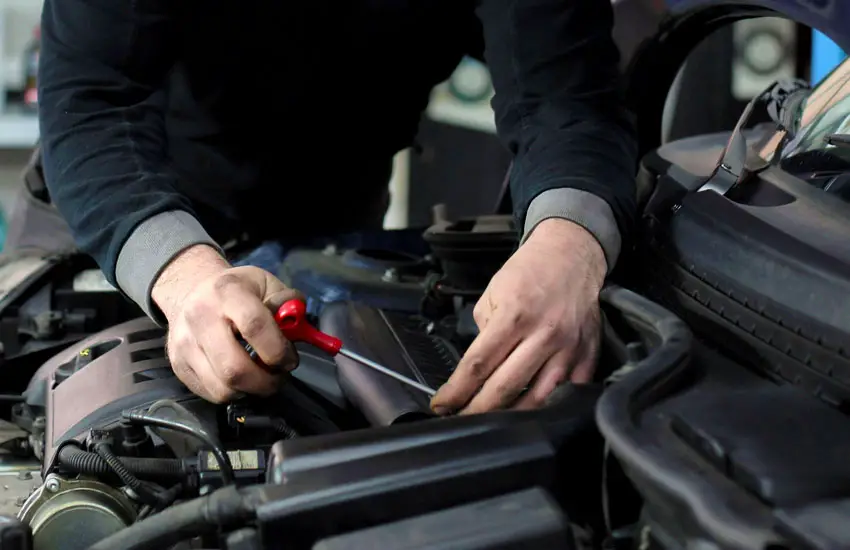As an Amazon Associate, I earn from qualifying purchases at no extra cost to you.
How to Change Transmission Fluid and Filter: Master the Fluid Swap!
Changing the transmission fluid and filter is one of the most crucial maintenance tasks you can perform for your car. Over time, transmission fluid can degrade, and the filter can become clogged with debris, leading to poor transmission performance. If you want to keep your vehicle running smoothly and extend the life of your transmission, it’s essential to understand how to change both the fluid and the filter properly. In this article, we’ll guide you through the process step-by-step, ensuring that you have all the information needed to tackle this important task yourself.

Why Changing Transmission Fluid and Filter is Important
The transmission system is a vital part of your vehicle. It helps to transfer power from the engine to the wheels, allowing your car to move smoothly and efficiently. The transmission fluid lubricates the moving parts inside the transmission, keeping them cool and preventing wear and tear. Over time, however, this fluid can break down due to heat, friction, and exposure to contaminants. If the fluid becomes too old or dirty, it can cause your transmission to malfunction, leading to costly repairs or replacements.
The transmission filter, on the other hand, is designed to trap any particles, dirt, or metal shavings that may accumulate in the transmission fluid. A clogged filter can restrict fluid flow, causing your transmission to overheat or shift poorly. By regularly changing both the fluid and the filter, you can ensure that your transmission operates at its best, reducing the risk of transmission failure.
Benefits of Changing Transmission Fluid and Filter
- Improved Shifting Performance: Fresh transmission fluid makes shifting smoother, helping to prevent jerky or hard gear changes.
- Extended Transmission Life: By reducing friction and preventing overheating, a clean filter and new fluid will prolong the life of your transmission.
- Prevents Expensive Repairs: Regular maintenance can prevent serious transmission problems, saving you money on repairs or a complete transmission replacement.
- Improved Fuel Efficiency: When the transmission operates efficiently, it requires less effort to move the car, which can improve gas mileage.
When Should You Change Your Transmission Fluid and Filter?
The timing of when to change your transmission fluid and filter depends on several factors, including the type of vehicle you have, the driving conditions, and whether your car has a manual or automatic transmission. Generally, most car manufacturers recommend changing the transmission fluid every 30,000 to 60,000 miles. However, it's always best to check your vehicle’s owner manual for specific recommendations.
If you drive under harsh conditions, such as towing heavy loads or driving in hot climates, you might need to change your transmission fluid more often. Additionally, if you notice any of the following signs, it’s time to change your fluid and filter:
- Slipping gears
- Rough or delayed shifting
- Unusual noises coming from the transmission
- Warning lights on the dashboard related to the transmission
- A burning smell from the transmission
Step-by-Step Guide to Changing Transmission Fluid and Filter
Now that you understand the importance of changing transmission fluid and filters, it's time to learn how to do it yourself. While the process can vary slightly depending on your vehicle's make and model, the following steps are generally applicable to most cars with automatic transmissions. If you’re working with a manual transmission, the process will differ slightly.
Tools and Materials You Will Need
Before starting the job, make sure you have the following tools and materials ready:
- Transmission fluid: Be sure to choose the correct type of transmission fluid recommended by your car's manufacturer.
- Transmission filter: You can find the filter in most automotive stores or online, but make sure it's compatible with your vehicle.
- Drain pan: This will catch the old fluid when you drain it from the transmission.
- Wrench set: You’ll need a wrench to remove the transmission pan bolts.
- Socket and ratchet: A socket and ratchet set are necessary for loosening bolts.
- Funnel: To add new fluid to the transmission without spilling.
- Jack and jack stands: If necessary, use a jack to lift your vehicle to gain access to the transmission pan.
- Rags: For cleaning up any spills or excess fluid.
Step 1: Lift the Vehicle
First, you'll need to lift the vehicle to access the transmission pan, which is typically located underneath your car. Use a car jack to lift the vehicle off the ground and secure it with jack stands. Ensure that the car is level so the fluid drains properly.
Step 2: Locate the Transmission Pan
The transmission pan is usually a rectangular or square-shaped metal plate located underneath your vehicle. Consult your car's owner's manual if you're unsure where it is. The pan is typically secured with bolts, and it contains both the fluid and the filter.
Step 3: Drain the Old Fluid
Before removing the pan, you'll need to drain the old fluid. Place a drain pan underneath the transmission pan to catch the fluid. Most vehicles have a drain plug at the bottom of the pan. If your car has one, use a wrench to loosen the plug and allow the fluid to drain into the pan. If there is no drain plug, carefully remove the bolts securing the transmission pan. Be prepared for the fluid to flow out as soon as the pan is removed.
Step 4: Remove the Transmission Pan
Once the fluid has drained, use a wrench or socket set to remove the bolts from the transmission pan. Carefully lift the pan off the transmission, taking care not to damage the gasket or spill any fluid. Depending on your vehicle, you may need to remove several bolts in a criss-cross pattern to avoid warping the pan.
Step 5: Remove the Old Filter
With the pan removed, you should see the transmission filter. The filter is typically held in place by a few screws or clips. Use a screwdriver or socket wrench to remove the screws, and carefully lift the filter out of the transmission. Be mindful of any remaining fluid that may still be in the filter.
Step 6: Install the New Filter
Take your new transmission filter and install it in the same position as the old one. Ensure that it fits securely and aligns properly. If necessary, use new screws or clips to secure the filter in place.
Step 7: Clean the Transmission Pan
Before reinstalling the transmission pan, take a moment to clean it. Remove any metal shavings or debris that may have collected in the pan. It's also a good idea to clean the pan's magnet (if your car has one) to remove any metal particles. Use a rag or paper towels to wipe the inside of the pan, and ensure there is no debris that could clog the new filter.
Step 8: Install a New Gasket
To ensure a proper seal, it's recommended to install a new gasket on the transmission pan. This will help prevent leaks when you reinstall the pan. Place the gasket in the groove of the transmission pan and ensure that it fits snugly.
Step 9: Reinstall the Transmission Pan
Carefully reinstall the transmission pan, aligning it with the holes in the transmission. Tighten the bolts in a criss-cross pattern to ensure an even seal. Be careful not to overtighten the bolts, as this can damage the gasket or warp the pan.
Step 10: Add New Transmission Fluid
Now that the pan and filter are back in place, it's time to add the new transmission fluid. Locate the transmission fluid dipstick (usually near the back of the engine) and use a funnel to pour the new fluid into the transmission. Check your vehicle's owner's manual for the recommended fluid type and quantity.
Step 11: Check Fluid Levels
After adding the fluid, start your car and let it run for a few minutes to allow the fluid to circulate. Then, use the dipstick to check the fluid level. If necessary, add more fluid until it reaches the correct level. Be sure not to overfill the transmission, as this can cause problems.
Step 12: Test the Transmission
Finally, take your car for a short test drive to ensure that the transmission is shifting smoothly and that there are no leaks. If everything seems to be functioning properly, you've successfully changed the transmission fluid and filter.
I hope this step-by-step guide has helped you understand the process of changing your transmission fluid and filter. Regular maintenance of your transmission is essential to ensure the longevity and smooth operation of your vehicle. By following these steps, you can tackle the job yourself and keep your car running like new.
Are These Questions in Your Mind?
Is it necessary to change transmission fluid regularly?
Yes, changing your transmission fluid regularly is important for maintaining the performance and longevity of your transmission. Over time, the fluid can break down, and contaminants can build up, which can cause shifting problems and other issues.
Can I change the transmission fluid without changing the filter?
While it's possible to change the transmission fluid without replacing the filter, it's generally recommended to change both at the same time. The filter traps contaminants, and if it becomes clogged, it can reduce the fluid flow and cause transmission problems.
Do I need special tools to change the transmission fluid?
For most vehicles, you will need a basic set of tools, including wrenches, a socket set, and a drain pan. You will also need new transmission fluid and a replacement filter. Make sure to have all the necessary tools before starting the job.
Is it difficult to change the transmission fluid and filter?
Changing the transmission fluid and filter is a moderately challenging task, especially if you've never worked on cars before. However, with the right tools, a little patience, and the step-by-step guide, it's something most car owners can handle.
Is it safe to drive with old transmission fluid?
Driving with old or degraded transmission fluid can cause a range of problems, including rough shifting, overheating, and eventually, complete transmission failure. It’s not recommended to drive with old transmission fluid for extended periods, especially if you notice symptoms of poor transmission performance. It's best to change it as soon as you can.
Can I change the transmission fluid without lifting the car?
For most cars, lifting the car is necessary to access the transmission pan and drain the fluid. However, some vehicles are designed in a way that allows you to change the transmission fluid without lifting the car. Check your vehicle's manual or look for specific instructions for your model to see if this is possible.
Do I need to drain the transmission fluid before changing the filter?
Yes, you should drain the transmission fluid before changing the filter. This allows you to remove the pan safely and replace the filter without spilling excess fluid. Draining the fluid first ensures that you won't cause a mess when removing the transmission pan.
Is it okay to change the transmission fluid myself?
Changing the transmission fluid yourself is completely feasible if you have some basic mechanical knowledge and the right tools. It's a great way to save money on labor costs at a shop. However, if you're unsure about the process or uncomfortable with working on your car, it's best to seek professional help.
Can I reuse the transmission pan gasket?
While it’s possible to reuse a transmission pan gasket if it's in good condition, it's generally recommended to replace it every time you change the fluid and filter. A new gasket ensures a proper seal, preventing leaks and potential damage to the transmission.
Is it necessary to check the fluid level after changing the transmission fluid?
Yes, after changing the transmission fluid, it’s essential to check the fluid level to ensure that it's within the proper range. The fluid level may need to be topped off after circulating through the transmission. Always check the fluid while the car is running and the transmission is warm for the most accurate reading.
Do I need to replace the transmission filter every time I change the fluid?
It's generally recommended to replace the transmission filter every time you change the fluid, especially if you’re doing a full fluid change. A clogged or old filter can reduce the fluid flow, leading to transmission issues. Replacing both the fluid and filter together ensures that the system is clean and functioning properly.











